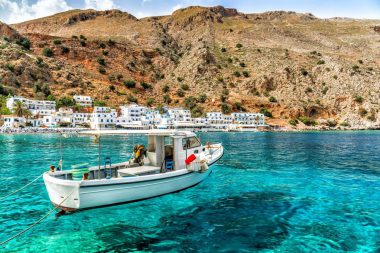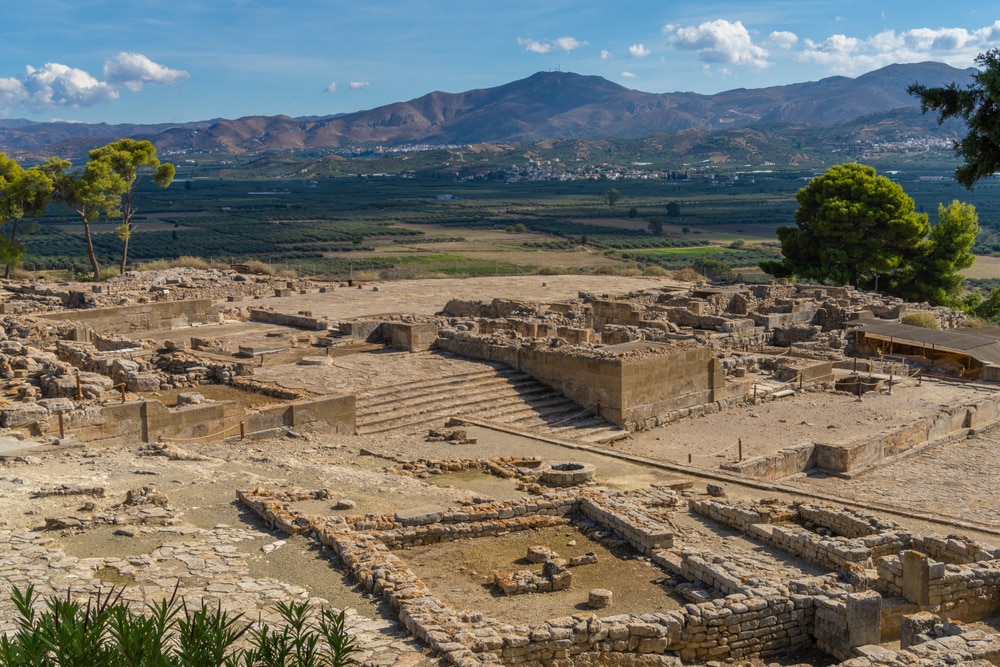Once upon a time, the Minoans built the palace of Phaistos (Festós) on the south coast of Crete. The palace complex was considered the second most important center of power after Knossos on the island. It was a residence, trading centre and meeting place for cultic ceremonies at the same time. The architecture suggests that the Minoan culture was exceptionally highly developed.
The Palace of Phaistos – Travel Tip for History Fans
Mystical places, museums, monasteries and ruins – Crete has a lot to offer. In addition to the Palace of Zakrós and the Palace of Knossos , the Minoan Palace of Phaistos is also one of the most beautiful sights.
The Palace of Phaistos is one of the most important archaeological sites in Crete and a must-see for all history buffs. For them, it is an unforgettable experience to visit the large central courtyard, the grand staircase, the royal apartments and the inconspicuous place where the legendary Phaistos Disc was found.
The biggest advantage for travelers is the relatively short flight time to Crete. With a direct flight, holidaymakers from Germany can reach the island within two to three hours (depending on the provider and departure city). Phaistos is considered an insider tip for visitors to Crete. The place is less crowded than Knossos and offers beautiful surroundings.
The History of the Minoan Palace of Phaistos
It is believed that the ridge and the Messara plain were already inhabited from about 4000 BC. The oldest finds from the region date back to around 3000 BC. It is said to have been King Minos himself who once founded the settlement.
In the Old Palace period between 1900 and 1700 BC, the Minoan culture flourished. Thus, the first palace was built in Phaistos in the period 1900 BC. He was just as important as Knossos. The palace complex was located on a ridge above the Messara plain near the south coast and covered an area of 8,400 square kilometers.
On a neighboring hill, about two kilometers northwest of Phaistos, stood another Minoan palace complex. Because the Minoan name was not known, it was named after a Byzantine church, the “Agia Triada”. A paved path connected the two palaces.
Around 1700 BC, an earthquake destroyed the palace complex, which was rebuilt immediately afterwards. However, the new building was never completed. At the same time, a new palace was built in the neighboring town of Agia Triada, which was better equipped. Therefore, historians assume that Agia Triada established itself as a new center of power, while Phaistos continued to exist as an economic and cultic center.
Excavation work in Phaistos from 1900

In 1900, the Italian Archaeological School, under the direction of Luigi Pernier and Professor Frederico Halbherr, began the first excavation work in the area around Phaistos. In order to be able to uncover parts of the previous and new palace of Phaistos, the archaeologists had to demolish buildings that were built above it in later eras. Most of the existing building remains belonged to the new palace complex. With the building of the upper courtyard and the Greek temple of Rhea, some of the buildings from the post-Minoan period have been preserved.
After the end of the Second World War, Doro Levi continued the excavation work. He focused primarily on the ancient palace of Phaistos and various areas of the city. Later, the work was extended to the surroundings of the hill on which the palace sat and the houses built on its slopes after the destruction of the palace complex.
Unlike in Knossos, only conservation work has taken place in Phaistos so far, but no restorations. Excavations continue to this day, while the palace area has been opened to visitors. The former accommodation of the archaeologists, which is located above the palace complex, has been converted into a tourist pavilion.
The Phaistos Disc
A special find from 1908 was a fired clay disc – the Phaistos Disc. The clay disc has a diameter of 16 centimetres, is two centimetres thick and has spirally arranged pictorial signs on both sides.
The wildest theories about the meaning of the signs on the clay disc are entwined. Numerous historians have already tried to solve the mystery of the disc. Some suspected a collection of hieroglyphics, others thought they recognized a language of letters or syllables. Still others thought of a millennium calendar or an astronomical map. Some even interpreted instructions for lovemaking into it. Depending on the approach, the content was written in Minoan, Proto-Greek, the former general language of Asia Minor, Luwian, or an “extraterrestrial” language.
Although the clay disc was found in a mountain of pottery and rubble in a storeroom in the old palace of Phaistos, it is still not clear where and from what time it actually originated. Pernier dated his find to 1700 BC. The Phaistos Disc can be visited today in the Archaeological Museum in Heraklion (Heraklion), along with many other finds from Phaistos.
Conclusion: Phaistos is the most beautiful of the Minoan palaces
Crete is the largest island in Greece and a popular tourist destination. The Mediterranean island offers its visitors a charming landscape with a specific flora and fauna. Four mountain ranges run through the island: the Dikti Mountains, the Ida Mountains, the White Mountains (Lefka Ori) and the small Thripti Mountains. The climate is moderate in both summer and winter. Crete is so popular with holidaymakers not least because of the approximately 300 days of sunshine a year. But the island also has a lot to offer in terms of culture.
In addition to the Palace of Knossos, there is another particularly historic attraction on the island: the Palace of Phaistos, also called Phaestos or Festós. It is located in the central south of Crete on the eastern foothills of Kastri Hill on the fertile Messara plain. With its imposing construction and advanced architectural composition, Phaistos is considered the most typical and beautiful of all Minoan palaces. The ruins of the former Minoan settlement have been preserved and can now be visited all year round by visitors to Crete who are interested in history.


